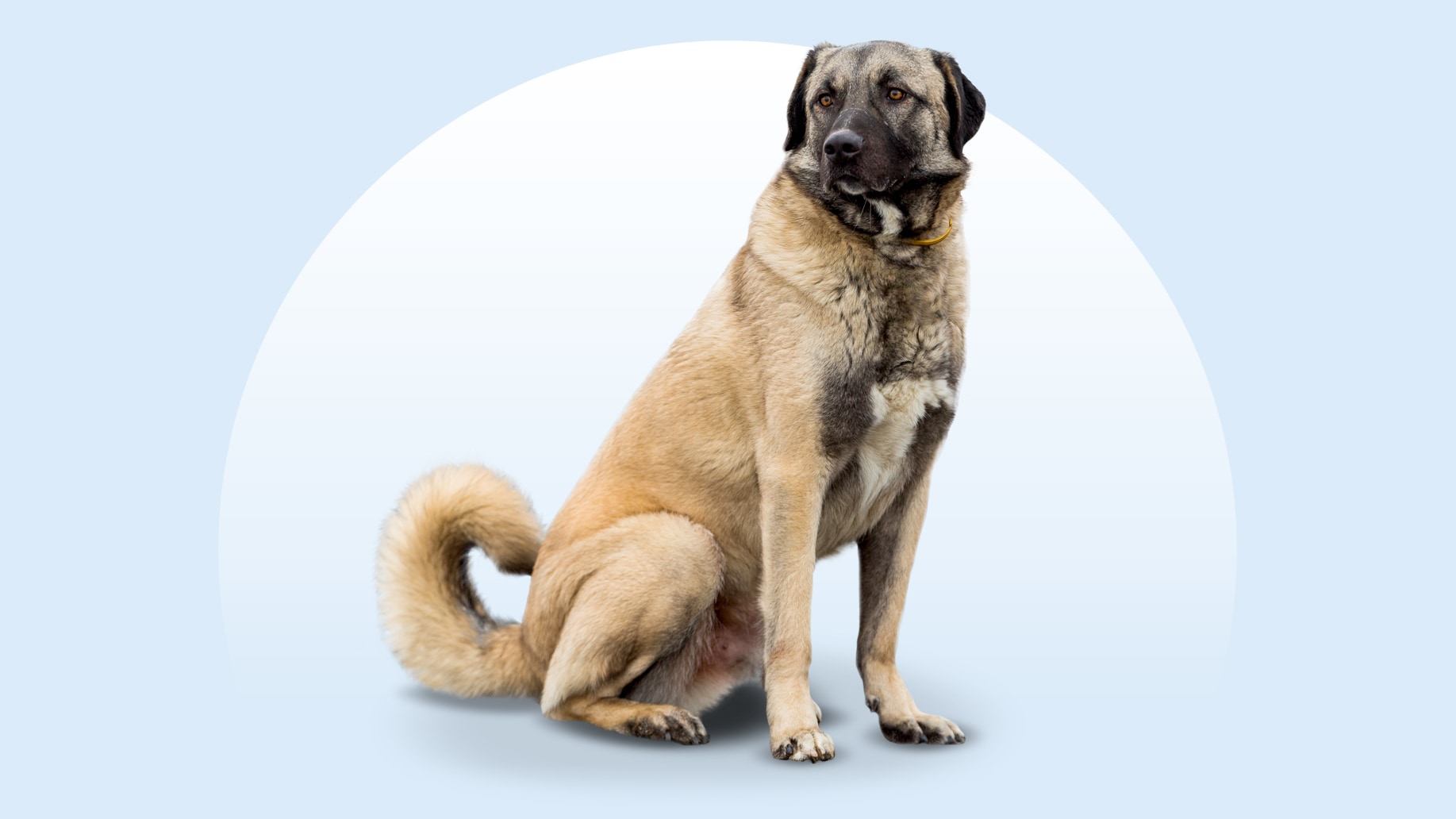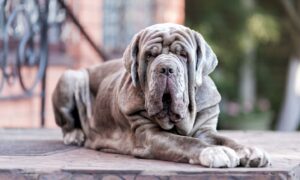Anatolian Shepherd
Updated August 21, 2025
Anatolian Shepherd
Updated August 21, 2025
The elegant and dignified Anatolian Shepherd probably won’t show you much affection if you’re just an acquaintance; it’s nothing personal. But with their family, these serious-seeming pups chill out and become their happiest, most charming selves. Bonus points if you love the calm of the great outdoors as much as they do.
Graceful, Introverted, Loyal
80–150 pounds
27–29 inches
11–13 years
Biscuit and White, Brindle, Blue Fawn, Brindle, Fawn, Gray Fawn, Red Fawn, Liver, White
If Anatolian Shepherds could text, they’d probably use proper punctuation. Smiley emojis? Absolutely not. Sending a meme just for fun? Undignified.
But that’s just their public persona. These graceful pups are very serious with strangers—who can blame them for being wary of the world, really? But when it comes to time with family, they’ll unleash their playful side and be a totally different dog; if you take them on a fun outdoor adventure, you might even get some heart emojis sent your way.
Anatolian Shepherd Characteristics
Anatolian Shepherd Appearance
Anatolian Shepherds move gracefully in the world, and they have a calm, reassuring gaze. Most have a beige coat, and they have darker masking on their face. A giant breed, they can weigh as much as 150 pounds.

- Ears
Their droopy ears sit on the sides of their head and are around 6 inches long.
- Eyes
Their almond-shaped eyes are hues from amber to brown.
- Nose
They have a solid brown or black nose on a square muzzle.
- Coat Length
Anatolian Shepherds have a dense undercoat as well as an overcoat that’s either short (about 1 inch) or long and rough (approximately 4 inches). They may have slightly longer fur around their neck, as well as feathering on their ear ends, legs, and tails.
- Coat Color
Anatolian Shepherd colors include white, fawn (a pale yellow-tan), and a biscuit-and-white combo. You’ll also see Anatolian Shepherds whose coats are brindle (subtle tiger stripes), liver (brown), or blue, red, or gray shades of fawn. They usually have a darker mask pattern on their face.
- Tail
Their long, high-set tail is carried low with a curl at the end or in a circle over their back.
Anatolian Shepherd Temperament
Giant yet graceful, the Anatolian Shepherd is a smart pup who loves to keep busy.
The Anatolian Shepherd personality is calm and reserved; this pup finds peace in the outdoors, and they’ll appreciate a pet parent who does too. They’re intelligent canines who are up for a hike or adventure, and they’ll wow you with their impressive speed (they can run up to 30 mph, so make sure you’re somewhere fenced—if these dogs get away from you, you won’t be able to keep up).
Anatolian Shepherds, just like some people, may come off a bit aloof (and they generally are with strangers), but they’re a whole other dog to their family: loving, loyal, and kind. If well-socialized, they’ll learn it’s OK (and even healthy!) to have friends, and they may learn to love the company of others too.
But if they prefer to be their introverted selves, don’t push them to go outside their social comfort zone. Either way, they’ll probably save the truly lavish displays of affection (hello, sloppy kisses) for the family.
How to Care for a Anatolian Shepherd
An Anatolian Shepherd needs solid training, regular grooming, and exercises that stimulate both their body and mind. Even though they tend to be reserved, they’ll love bonding time with their favorite person.
Grooming
Training
Diet
Exercise
Environment
Anatolian Shepherd Health
The Anatolian Shepherd lifespan is 11–13 years—an impressive stretch for such a giant breed. Here are some health issues to be aware of.
- Anesthesia sensitivity: Anatolian Shepherds absorb drugs more slowly, which means that they’re slower to recover from general anesthesia or heavy sedation. Discuss any concerns with your vet.
- Bloat and gastric dilatation-volvulus (GDV): Anatolian Shepherds, like all deep-chested breeds, are prone to a life-threatening condition called bloat. It occurs when the stomach gets distended with air and/or food. A serious complication of bloat is when the stomach twists on itself, cutting off blood supply to the organs. This is called GDV, and symptoms include abdominal distension, restlessness, and dry heaving. If you notice these signs, go to the vet immediately. To avoid bloat, use a slow feeder and feed your dog smaller meals throughout the day. Keep their food bowls on the ground (don’t elevate them) and don’t exercise one hour before or after meals.
- Entropion: In this eye condition, the eyelid grows inward and causes the eyelashes to rub against the eye’s surface. Eye infections and corneal ulcers can occur as a result of this condition, which is often treated with surgery.
- Hip dysplasia: Hip dysplasia is when the ball and socket of the hip and thigh bones doesn’t properly fit. It’s an inherited condition that can be made worse if a pup is overweight. It eventually leads to arthritis and pain. More severe cases may require surgery, but the condition is often treated with medications, joint supplements, special diets, weight management, and/or physical therapy.
- Hypothyroidism: Hypothyroidism is one of the most common endocrine disorders in dogs that results in decreased production of thyroid hormones. It can be diagnosed with a blood test, so thyroid levels should be a normal part of screening bloodwork as your dog ages. Hypothyroidism commonly causes skin and ear infections as well as weight gain and sluggishness. It can be managed with oral meds.
Anatolian Shepherd History
The Anatolian Shepherd comes from (surprise) the Anatolian region of Turkey. Ancient artifacts show the breed’s origins may date back as early as 2000 BCE.
Modern Anatolian Shepherds descended from the Coban Kopegi (“shepherd’s dog”) that took care of sheep and goats. Unlike the herding dogs who moved the flock from location to location, the Coban Kopegi was a guardian dog, patiently watching over their charges.
Those ancient dogs were likely bred from the Roman Molossus and the Tibetan Mastiff. They were known for their independence and loyalty, traits the Anatolians and other Turkish shepherds of today still possess—like the Turkish Kangal, also known as the Kangal Shepherd Dog.
Their reputation as a guardian dog led to their inclusion in the “Sheepdog Project,” in which the federal government hoped to find pups best intended to be guardian dogs to protect the U.S. sheep population.
They did a phenomenal job of keeping wolves and other dangers away—just by their sly, intense stare.
The American Kennel Club officially recognized Anatolian Shepherds as an established breed in 1996.
Most of these pups are now far from their working dog days and living a lush life in their adopted homes (as they should be). Remarkably, though, there are some who still work as guardian dogs—and they’re helping to restore cheetah populations in Africa.
Anatolian Shepherds warn cheetahs off property in Namibia. As a result, communities no longer see the cheetahs as a threat, and fewer are killed or harmed—all because of one very smart dog breed.
Anatolian Shepherd puppies tend to be anywhere from $800 to $1,500. If you choose this route, pick a responsible breeder.
Ideally, though, you can adopt an Anatolian Shepherd. Check out a rescue organization like the National Anatolian Shepherd Rescue Network, keep an eye out at your local shelter, or search Chewy’s database of adoptable dogs in your area.








